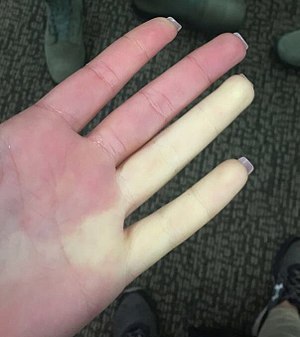
Primary Raynaud's phenomenon

Raynaud syndrome, also known as Raynaud's phenomenon, is a medical condition in which spasm of arteries cause episodes of reduced blood flow. Typically, the fingers, and less commonly the toes, are involved. Rarely, the nose, ears, or lips are affected. The episodes result in the affected part turning white and then blue. Often, numbness or pain occurs. As blood flow returns, the area turns red and burns. The episodes typically last minutes, but can last several hours. Episodes are often triggered by cold or emotional stress. The two main types are primary Raynaud's, when the cause is unknown, and secondary Raynaud's, which occurs as a result of another condition. Secondary Raynaud's can occur due to a connective-tissue disorder, such as scleroderma or lupus, injuries to the hands, prolonged vibration, smoking, thyroid problems, and certain medications, such as birth control pills. Diagnosis is typically based on the symptoms. The primary treatment is avoiding the cold. Other measures include the discontinuation of nicotine or stimulants use. Medications for treatment of cases that do not improve include calcium channel blockers and iloprost. Little evidence supports alternative medicine. Severe disease may rarely be complicated by skin sores or gangrene. About 4% of people have the condition. Onset of the primary form is typically between ages 15 and 30 and occurs more frequently in females. The secondary form usually affects older people. Both forms are more common in cold climates. It is named after the French physician Maurice Raynaud, who described the condition in 1862.
